
Cleo's Story
Cleo was a Nile monitor. Most Nile
monitors are known for their
irrascable dispositions, paranoid outlook on life, high strung nerves,
and intractable temperments. Cleo was different. Although not exactly
trusting of strangers, she did tolerate being touched and handled in a
familiar environment. Her unusual intelligence and quiet presence made
her an important part of my household.
Cleo's Beginnings
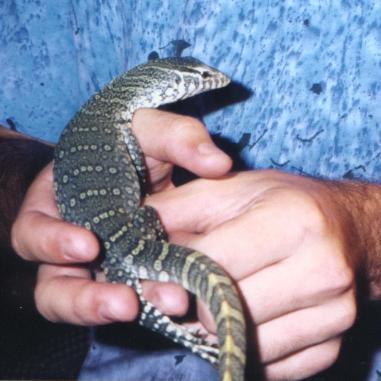 I aquired Cleo at a repile show in San
Francisco in 1994 as a hatchling.
At the same time, I purchased a second hatchling Nile monitor which I
named Rameses. From the beginning, Cleo was calmer and friendlier than
Rameses. She quickly got to the point where she stopped biting and
deficating when picked up, and although baby monitors can be expected to
be a bit squirmy, Cleo would usually calm down and let herself be
handled. She also developed a peculiar habit that lasted throughout her
life - she liked to perch on the top of my head. After a few months,
Rameses sickened and quickly died, leaving me with only one Nile monitor.
I aquired Cleo at a repile show in San
Francisco in 1994 as a hatchling.
At the same time, I purchased a second hatchling Nile monitor which I
named Rameses. From the beginning, Cleo was calmer and friendlier than
Rameses. She quickly got to the point where she stopped biting and
deficating when picked up, and although baby monitors can be expected to
be a bit squirmy, Cleo would usually calm down and let herself be
handled. She also developed a peculiar habit that lasted throughout her
life - she liked to perch on the top of my head. After a few months,
Rameses sickened and quickly died, leaving me with only one Nile monitor.
Cleo as a baby. Wasn't she adorable?
(baby photos by Jean Campbell)
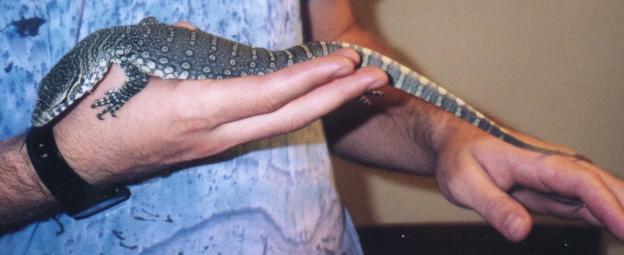
Housing
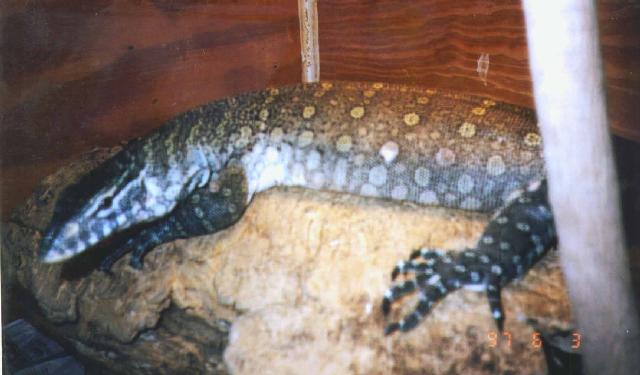
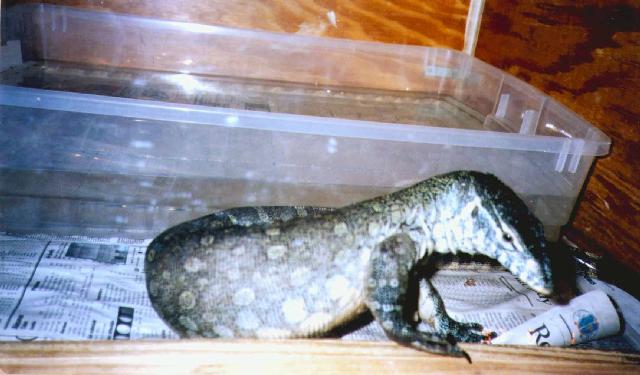
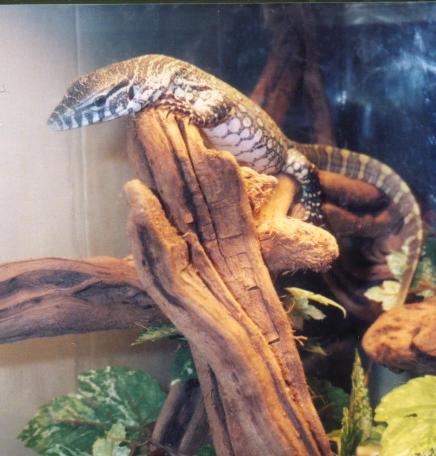 Cleo was originally housed in a ten
gallon
aquarium. Monitors, however, grow rapidly, and before long I was forced
to move her into new quarters. A 30 gallon aquarium served her needs
after I moved to Seattle in the summer of '95, but soon she was relocated
to a 60 gallon aquarium, and finally a custom built wood enclosure, 150
cm by 60 cm by 60 cm, with sliding plexiglas doors and screen ventilation
on top. This served for about a year. Since monitors are such active
animals, they should have plenty of room to roam, and at this time, I
felt I had no choice but to let Cleo have the run of the appartment.
Cleo was originally housed in a ten
gallon
aquarium. Monitors, however, grow rapidly, and before long I was forced
to move her into new quarters. A 30 gallon aquarium served her needs
after I moved to Seattle in the summer of '95, but soon she was relocated
to a 60 gallon aquarium, and finally a custom built wood enclosure, 150
cm by 60 cm by 60 cm, with sliding plexiglas doors and screen ventilation
on top. This served for about a year. Since monitors are such active
animals, they should have plenty of room to roam, and at this time, I
felt I had no choice but to let Cleo have the run of the appartment.
Cleo on the Loose
Once let out, Cleo wasted no time in
making a big mess. She would climb up the bookshelves, knocking all the
books down. She would dig up the potted plants, or just climb on them
and break their stems. Nothing was safe, and anything left out soon fell
victim to her curiosity. She could get anywhere, even the places that
were barricaded off from the ferrets.
At first, I resigned myself to
having to pick up the objects that Cleo would occasionally strew about
(and dispose of the plants she killed), but before too long, a problem
developed. Like most lizards, monitors like to hide in burrows,
crevices, and the like. The more inaccessable, the better. This makes
them feel secure from big nasty predators, like humans. At first, Cleo
chose to hide in the couch. No, not under the couch, in the
couch. I feel strongly that I should be able to get to my pets when
neccessary, in case a problem arises, for example. Thus, after several
days of Cleo hiding in the couch, and not coming out even to be fed, I
finally cut the bottom of the couch open to extract her. This ruined the
spring supports, so the couch sagged ever after that. Of course, now
that her hiding spot was less secure, she had to find some place else.
The book case was not that much of a problem, I could just shift the book
case. Finally, however, she found the stove.
Cleo and the Stove
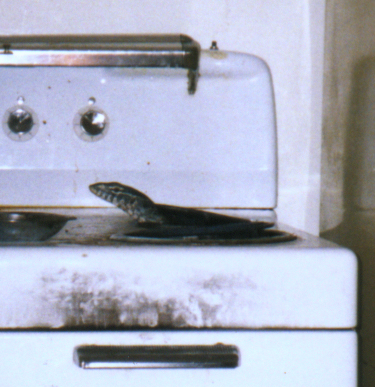 By climbing behind the stove,
Cleo could
get up inside of
it. At first, she stayed down by the drawers. By pulling out the
drawers, I could get to her. Of course, Cleo didn't like anyone being
able to get to her, so she climbed higher. Each time I found a way to
get her out, she found a way to make herself even more inaccessable. I
tried to keep her out of the stove by sealing off any way for her to get
behind it. A stack of books wedged between the stove and the
refrigerator were easily climbed. A strip of plywood duct-taped to the
entrance fared no better. To seal off the top of the stove, I stuck
strips of duct tape between the top of the stove and the refrigerator and
the wall. She just went in behind the other side of the refrigerator.
I sealed off the entire back of the refrigerator, and she pulled off the
narrow grill at the bottom to climb under the refrigerator, and from
there to the back of the stove. Finally, my kitchen was a mess of
plywood, duct tape and hardware cloth, and still nothing worked. Cleo
could get over, around, under, or through and barrier I put up. When I
saw her chimney up the narrow crevice between the stove and refrigerator
and then dig through the duct tape, I finally gave up. Each
time I got her out, though, she went into more inaccessable parts of the
stove. Finally, she climbed up into the part on the top-back that has
all the dials for setting temperature. This was of solid metal
construction, and the only way in required more flexibility that the
human arm was capable of. There was no way of extracting her.
By climbing behind the stove,
Cleo could
get up inside of
it. At first, she stayed down by the drawers. By pulling out the
drawers, I could get to her. Of course, Cleo didn't like anyone being
able to get to her, so she climbed higher. Each time I found a way to
get her out, she found a way to make herself even more inaccessable. I
tried to keep her out of the stove by sealing off any way for her to get
behind it. A stack of books wedged between the stove and the
refrigerator were easily climbed. A strip of plywood duct-taped to the
entrance fared no better. To seal off the top of the stove, I stuck
strips of duct tape between the top of the stove and the refrigerator and
the wall. She just went in behind the other side of the refrigerator.
I sealed off the entire back of the refrigerator, and she pulled off the
narrow grill at the bottom to climb under the refrigerator, and from
there to the back of the stove. Finally, my kitchen was a mess of
plywood, duct tape and hardware cloth, and still nothing worked. Cleo
could get over, around, under, or through and barrier I put up. When I
saw her chimney up the narrow crevice between the stove and refrigerator
and then dig through the duct tape, I finally gave up. Each
time I got her out, though, she went into more inaccessable parts of the
stove. Finally, she climbed up into the part on the top-back that has
all the dials for setting temperature. This was of solid metal
construction, and the only way in required more flexibility that the
human arm was capable of. There was no way of extracting her.
She
stayed in there for weeks. Sometimes, she would poke her head out one of
the burners. One of those times, I was quick enough to run over, reach
under the burner, and grab her tail before she could hide away
completely. After a prolonged struggle, I was able to drag her, hissing,
and scratching, from the stove. After that, I put up a plywood barrier
separating the kitchen from the living room (the appartment didn't have
doors). Cleo got to stay in the living room. At the time, it seemed a
sheer, vertical, one meter high barrier of solid plywood (with a gate
thet people could use) was too much for even Cleo to climb. However, I
had to clear the area in front of the barrier of all furnature to a
distance of one and a half meters, or Cleo could climb up on the
furnature and jump up to the top of the barrier. I found out later that
Cleo could, in fact, climb the plywood wall, probably by putting her arms
and legs on either side of the 2x4 frame that held the gate and pushing
inward. This provided enough friction that she could wiggle up, despite
the lack of foot or claw holds. My best guess is that she just got tired
of the fight, and settled for one of the hide spots I provided her.
Grievous Bodily Harm
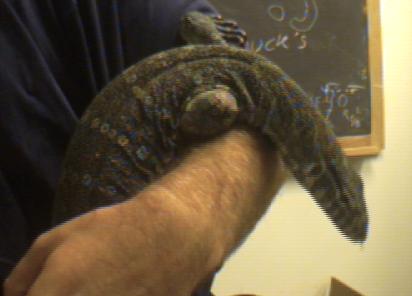 Although Cleo was usually fairly
calm around
people she knew in a familiar setting, she didn't like being restrained
when picked up. If you lifted her gently without grabbing, supporting
her body in your hands, she would usually just try to calmly walk away.
By placing the hand she just walked off of in front of her, you could
treadmill her quite effectively, and in so doing so move her to wherever
she needed to go. However, when grabbed, or even worse, dragged out from
her hiding spot, she would take pains to escape. This involved reaching
up with her back feet to get a purchase, usually on your wrists, and then
pushing off with those feet to try to run away. Of course, since you had
a good grip on her, she wouldn't go anywhere, but her claws sure would!
They would be pushed back across your wrists with force, cutting painful
and ugly wounds. Fortunately, these lacerations were superficial, but
for several days you would have red streaks lacing your wrists, palms,
and forearms.
Although Cleo was usually fairly
calm around
people she knew in a familiar setting, she didn't like being restrained
when picked up. If you lifted her gently without grabbing, supporting
her body in your hands, she would usually just try to calmly walk away.
By placing the hand she just walked off of in front of her, you could
treadmill her quite effectively, and in so doing so move her to wherever
she needed to go. However, when grabbed, or even worse, dragged out from
her hiding spot, she would take pains to escape. This involved reaching
up with her back feet to get a purchase, usually on your wrists, and then
pushing off with those feet to try to run away. Of course, since you had
a good grip on her, she wouldn't go anywhere, but her claws sure would!
They would be pushed back across your wrists with force, cutting painful
and ugly wounds. Fortunately, these lacerations were superficial, but
for several days you would have red streaks lacing your wrists, palms,
and forearms.
On rare occasions, Cleo was so frightened by being
grabbed in such a way that she bit. Nile monitors have very powerful
jaws, strong enough to crush clam shells. In addition, the front teeth
are quite sharp (the back teeth are blunt, for better crushing). I was
lucky in that none of these bites were particularly severe. In one case
when she was a sub-adult, she panicked when I was giving her a bath. As
she dashed around the bathroom, I grabbed her and she immediatly twisted
around and grabbed back, but with her mouth. Since she was not an adult
at the time, the bite was not that bad.
Another time, my parents
were looking after her when I was ill. When I was mostly recovered, I
went over for a visit. Cleo did not seem to like her new home. She was
extremely nervous, staying under cover and struggling like crazy when
taken out of her enclosure. At first, I thought this was because my
parents didn't handle her the entire time she stayed with them. After
telling them they should take her out more to get her used to humans, I
took my mom to show her how it was done. Of course, Cleo chose that time
to bite. It was not a very good bite, she only barely got a hold of some
skin on the back of my left ring finger with the side of her mouth, but
she held on like a bulldog with crushing strength. After putting dijon
mustard in her mouth and prying at her jaws with a butter knife, we were
able to release her grip. The wound bled freely, but after being
disinfected with peroxide and wrapped up, it healed without incident. I
still have a scar. I fear the bite could have been much worse if she had
gotten a more solid grip, possibly ending with a broken finger bone.
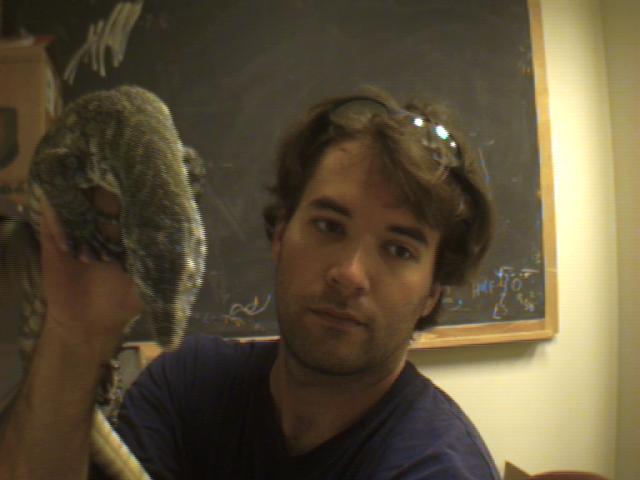 Perhaps the most curious of the
bites I recieved from Cleo came not
because she was nervous, but because she was hungry. As mentined
earlier, Cleo liked to climb on my head. When she was small, she would
hide among my hair. As she grew, she could no longer do this, but she
still liked the high, warm vantage point. I did discover a potential
problem, though. It seems that the shaving cream I used that day smelled
irresistably tasty. Now monitors have an incredible sense of smell, and
even the remotest residue to a substance can be picked up. I'm guessing
that she smelled the chemical trace of the shaving cream I had used
earlier that morning, because as she was climbing up toward my head, she
bit my chin. Fortunately, she quickly realized her mistake and let go.
The bite was not very bad.
Perhaps the most curious of the
bites I recieved from Cleo came not
because she was nervous, but because she was hungry. As mentined
earlier, Cleo liked to climb on my head. When she was small, she would
hide among my hair. As she grew, she could no longer do this, but she
still liked the high, warm vantage point. I did discover a potential
problem, though. It seems that the shaving cream I used that day smelled
irresistably tasty. Now monitors have an incredible sense of smell, and
even the remotest residue to a substance can be picked up. I'm guessing
that she smelled the chemical trace of the shaving cream I had used
earlier that morning, because as she was climbing up toward my head, she
bit my chin. Fortunately, she quickly realized her mistake and let go.
The bite was not very bad.
Cleo undoubtedly bit me several times when she was just a hatchling and
still getting used to me, but the bites of a hatchling monitor are
comical rather than dangerous.
In addition to biting and clawing, monitor lizards can use their tail as
a sort of a combination between a whip and a club. Only once did I
sustain any noticable injury from her tail, when I was trying to put her
away when she was being obstreperous. In her lashing about as I held
her, her tail whacked my arm and left a welt. She would commonly employ
her tail against the other animals in my house, however. Monitors use
their tail as their first line of defense when approached to closely.
Blows from the tail keep threatening animals far enough away to avoid
close physical combat. Cleo would bludgeon and lash the savanna
monitors, the ferrets, and even some cats I was looking after for a
while. They all learned that Cleo wasn't very fun to play with (although
the cats seemed to find Cleo's long tail irresistable).
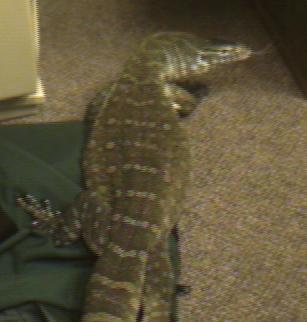
Heat
Cleo spent much of her time basking. She had a number of basking spots
to choose from, scattered about the living room. It was not uncommon to
see her stretched out under the "light table," or shacked up with the
savanna monitors under the contraption I nailed together to hold their
basking lamps. When she got good and warm, she would explore a bit, or
go crawl into her hiding place for a nap. She also liked to rest on top
of the highest cages, well above the level of my head. Perhaps it was
because warm air rises, but maybe she just liked the view.
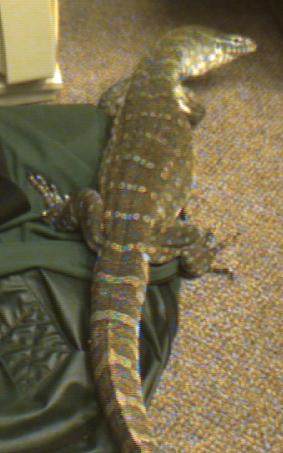 Feeding
Feeding
As my pet, I tried to feed Cleo a varied diet. I'd often hard-boil an
egg for her, and she would have fun crushing it, pulling it apart, eating
all the bits, and then spend hours sniffing the shells. I could give her
a handful of beetle larvae I got from the pet store, and she would dig
around for them and eat them, one by one. Goldfish by the dozens could be
dumped into her water dish for her enjoyment. Crayfish were collected
from nearby rivers, and she would crunch them up, while making a mess of
their guts. On rainy days, I would collect earthworms and snails off the
sidewalk. Snails would be crushed with enthusiasm, earthworms slurped
down like animated spagetti. Sometimes, she got the kind of cat food with
sliced chunks of meat, so she could easily pick them out without making
too much of a mess (cat food is high in fat, though, and should probably
only be fed sparingly to adult monitors). When I was eating meat for
dinner, Cleo would often get a few pieces.
What Cleo ate most, though was
mice. This was largely a matter of convenience, since mice could be
bought in large numbers fairly economically. At first, I gave her live
mice. After a while, I stopped this practice, for two reasons. One is
that an adult mouse is equipped with chissel-like incisors that can make
a narrow but deep wound. Such a wound can be easily infected and become
fairly serious. A monitor is more than a match for any mouse, but
sometimes, the mouse gets lucky. The other reason was convenience.
Frozen mice are cheaper, stink less, are easier to catch, don't bite, and
don't have to be cleaned, watered, and fed. They can be bought in bulk
and stored in the freezer until they are needed. A weeks worth can be
thawed at a time and stored in the refrigerator, then fed at the rate of
one per day.
She also got a lot of a mixture of ground turkey, ground calcium supplement, and mutivitamins.
I'll usually scoop out spoonfuls and either freeze or
refrigerate them, depending on how long I have to store them. A
standard
spoon scoop provides a bite size chunk and one day's meal.
The End
Late in 1998, Cleo died from an infection of the heart valve. She was
four years old. I found her in the morning when I was going round to
feed the all monitors, lying cold and unresponsive, curled up in a corner
near a heat lamp. She showed no earlier signs of illness. I took her
remains to
the vet for an autopsy, and there said my final goodbyes to this
wonderful lizard.
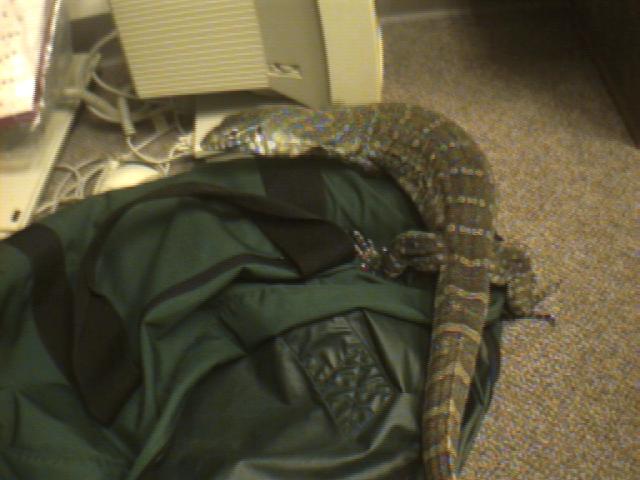
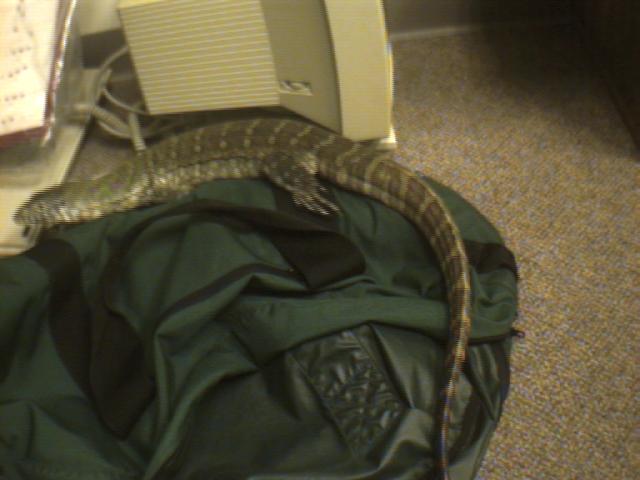
monitor
resources
back to herp page
 I aquired Cleo at a repile show in San
Francisco in 1994 as a hatchling.
At the same time, I purchased a second hatchling Nile monitor which I
named Rameses. From the beginning, Cleo was calmer and friendlier than
Rameses. She quickly got to the point where she stopped biting and
deficating when picked up, and although baby monitors can be expected to
be a bit squirmy, Cleo would usually calm down and let herself be
handled. She also developed a peculiar habit that lasted throughout her
life - she liked to perch on the top of my head. After a few months,
Rameses sickened and quickly died, leaving me with only one Nile monitor.
I aquired Cleo at a repile show in San
Francisco in 1994 as a hatchling.
At the same time, I purchased a second hatchling Nile monitor which I
named Rameses. From the beginning, Cleo was calmer and friendlier than
Rameses. She quickly got to the point where she stopped biting and
deficating when picked up, and although baby monitors can be expected to
be a bit squirmy, Cleo would usually calm down and let herself be
handled. She also developed a peculiar habit that lasted throughout her
life - she liked to perch on the top of my head. After a few months,
Rameses sickened and quickly died, leaving me with only one Nile monitor.




 Cleo was originally housed in a ten
gallon
aquarium. Monitors, however, grow rapidly, and before long I was forced
to move her into new quarters. A 30 gallon aquarium served her needs
after I moved to Seattle in the summer of '95, but soon she was relocated
to a 60 gallon aquarium, and finally a custom built wood enclosure, 150
cm by 60 cm by 60 cm, with sliding plexiglas doors and screen ventilation
on top. This served for about a year. Since monitors are such active
animals, they should have plenty of room to roam, and at this time, I
felt I had no choice but to let Cleo have the run of the appartment.
Cleo was originally housed in a ten
gallon
aquarium. Monitors, however, grow rapidly, and before long I was forced
to move her into new quarters. A 30 gallon aquarium served her needs
after I moved to Seattle in the summer of '95, but soon she was relocated
to a 60 gallon aquarium, and finally a custom built wood enclosure, 150
cm by 60 cm by 60 cm, with sliding plexiglas doors and screen ventilation
on top. This served for about a year. Since monitors are such active
animals, they should have plenty of room to roam, and at this time, I
felt I had no choice but to let Cleo have the run of the appartment.
 By climbing behind the stove,
Cleo could
get up inside of
it. At first, she stayed down by the drawers. By pulling out the
drawers, I could get to her. Of course, Cleo didn't like anyone being
able to get to her, so she climbed higher. Each time I found a way to
get her out, she found a way to make herself even more inaccessable. I
tried to keep her out of the stove by sealing off any way for her to get
behind it. A stack of books wedged between the stove and the
refrigerator were easily climbed. A strip of plywood duct-taped to the
entrance fared no better. To seal off the top of the stove, I stuck
strips of duct tape between the top of the stove and the refrigerator and
the wall. She just went in behind the other side of the refrigerator.
I sealed off the entire back of the refrigerator, and she pulled off the
narrow grill at the bottom to climb under the refrigerator, and from
there to the back of the stove. Finally, my kitchen was a mess of
plywood, duct tape and hardware cloth, and still nothing worked. Cleo
could get over, around, under, or through and barrier I put up. When I
saw her chimney up the narrow crevice between the stove and refrigerator
and then dig through the duct tape, I finally gave up. Each
time I got her out, though, she went into more inaccessable parts of the
stove. Finally, she climbed up into the part on the top-back that has
all the dials for setting temperature. This was of solid metal
construction, and the only way in required more flexibility that the
human arm was capable of. There was no way of extracting her.
By climbing behind the stove,
Cleo could
get up inside of
it. At first, she stayed down by the drawers. By pulling out the
drawers, I could get to her. Of course, Cleo didn't like anyone being
able to get to her, so she climbed higher. Each time I found a way to
get her out, she found a way to make herself even more inaccessable. I
tried to keep her out of the stove by sealing off any way for her to get
behind it. A stack of books wedged between the stove and the
refrigerator were easily climbed. A strip of plywood duct-taped to the
entrance fared no better. To seal off the top of the stove, I stuck
strips of duct tape between the top of the stove and the refrigerator and
the wall. She just went in behind the other side of the refrigerator.
I sealed off the entire back of the refrigerator, and she pulled off the
narrow grill at the bottom to climb under the refrigerator, and from
there to the back of the stove. Finally, my kitchen was a mess of
plywood, duct tape and hardware cloth, and still nothing worked. Cleo
could get over, around, under, or through and barrier I put up. When I
saw her chimney up the narrow crevice between the stove and refrigerator
and then dig through the duct tape, I finally gave up. Each
time I got her out, though, she went into more inaccessable parts of the
stove. Finally, she climbed up into the part on the top-back that has
all the dials for setting temperature. This was of solid metal
construction, and the only way in required more flexibility that the
human arm was capable of. There was no way of extracting her.
 Although Cleo was usually fairly
calm around
people she knew in a familiar setting, she didn't like being restrained
when picked up. If you lifted her gently without grabbing, supporting
her body in your hands, she would usually just try to calmly walk away.
By placing the hand she just walked off of in front of her, you could
treadmill her quite effectively, and in so doing so move her to wherever
she needed to go. However, when grabbed, or even worse, dragged out from
her hiding spot, she would take pains to escape. This involved reaching
up with her back feet to get a purchase, usually on your wrists, and then
pushing off with those feet to try to run away. Of course, since you had
a good grip on her, she wouldn't go anywhere, but her claws sure would!
They would be pushed back across your wrists with force, cutting painful
and ugly wounds. Fortunately, these lacerations were superficial, but
for several days you would have red streaks lacing your wrists, palms,
and forearms.
Although Cleo was usually fairly
calm around
people she knew in a familiar setting, she didn't like being restrained
when picked up. If you lifted her gently without grabbing, supporting
her body in your hands, she would usually just try to calmly walk away.
By placing the hand she just walked off of in front of her, you could
treadmill her quite effectively, and in so doing so move her to wherever
she needed to go. However, when grabbed, or even worse, dragged out from
her hiding spot, she would take pains to escape. This involved reaching
up with her back feet to get a purchase, usually on your wrists, and then
pushing off with those feet to try to run away. Of course, since you had
a good grip on her, she wouldn't go anywhere, but her claws sure would!
They would be pushed back across your wrists with force, cutting painful
and ugly wounds. Fortunately, these lacerations were superficial, but
for several days you would have red streaks lacing your wrists, palms,
and forearms.  Perhaps the most curious of the
bites I recieved from Cleo came not
because she was nervous, but because she was hungry. As mentined
earlier, Cleo liked to climb on my head. When she was small, she would
hide among my hair. As she grew, she could no longer do this, but she
still liked the high, warm vantage point. I did discover a potential
problem, though. It seems that the shaving cream I used that day smelled
irresistably tasty. Now monitors have an incredible sense of smell, and
even the remotest residue to a substance can be picked up. I'm guessing
that she smelled the chemical trace of the shaving cream I had used
earlier that morning, because as she was climbing up toward my head, she
bit my chin. Fortunately, she quickly realized her mistake and let go.
The bite was not very bad.
Perhaps the most curious of the
bites I recieved from Cleo came not
because she was nervous, but because she was hungry. As mentined
earlier, Cleo liked to climb on my head. When she was small, she would
hide among my hair. As she grew, she could no longer do this, but she
still liked the high, warm vantage point. I did discover a potential
problem, though. It seems that the shaving cream I used that day smelled
irresistably tasty. Now monitors have an incredible sense of smell, and
even the remotest residue to a substance can be picked up. I'm guessing
that she smelled the chemical trace of the shaving cream I had used
earlier that morning, because as she was climbing up toward my head, she
bit my chin. Fortunately, she quickly realized her mistake and let go.
The bite was not very bad.

 Feeding
Feeding

